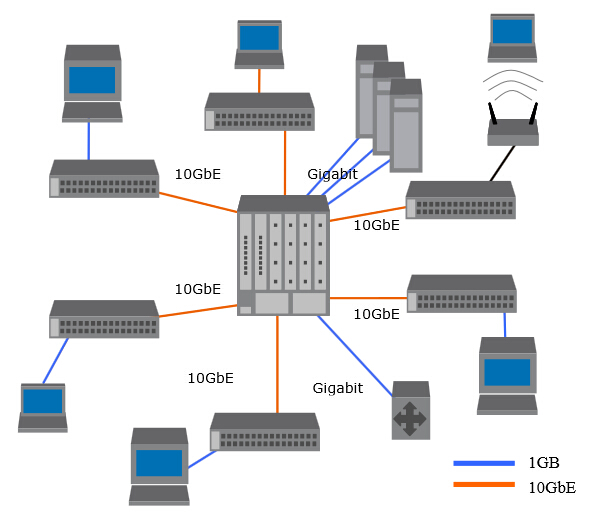Ethernet technology has continually evolved in order to meet the never-ending requirement for faster rates of data transmission. The demand for faster application speeds has also spurred technological evolution on data carrying techniques. As such, copper and fiber transmission standards have progressed, providing greater bandwidth for transporting data over Ethernet architectures with reduced cost and complexity. This article highlights the cabling solutions for 1 Gigabit Ethernet and 10 Gigabit Ethernet.
For 1 Gigabit Ethernet cabling, both fiber and copper cable connections are available.
The optical fiber cables are usually used for longer connections. Optical fiber connections are constructed with a combination of a transceiver, which receives digital signals from the Ethernet device (switch or adapter card) and converts them to optical signals for transmission over the fiber. The most widely used transceiver for 1 Gigabit Ethernet is SFP (small form factor pluggable). For instance, the Cisco GLC-LH-SMD 1000BASE-LX/LH SFP can support transmission distance up to 10 kilometers.
The difference in cable choices comes from the distance limitations encountered with the various types of optical transmission. Short range and long range are the two different commonly available types. Short range supports connections of up to 550 meters, while long range supports connections of up to 10 kilometers. Multimode fiber cables are typically used for short range transmission and single-mode fiber cables are used for long range transmission.
The final consideration on the fiber cable is the connector type. The main differences among types of connectors lie in dimensions and methods of mechanical coupling. Multimode fiber cables and single-mode fiber cables require different connectors. SC and LC connectors are the most common types.
For copper cables supporting 1 Gigabit Ethernet, the Category 5 unshielded twisted pair (Cat5-UTP) is utilized. With a RJ45 connector on either end, Cat 5 can support connections of up to 100 meters. Cat5e, an enhanced version of the Category 5, is the most used Ethernet cabling today. For lower speed (10 or 100 Mbps) connections, only two of the four pairs in Cat 5 cables are used. For 1 Gigabit Ethernet, all four pairs are used. The following picture shows the 1G and 10G application in an enterprise data center.

For 10 Gigabit Ethernet cabling, the cabling choices are nearly the same with the 1 Gigabit Ethernet. The fiber options are very similar. The transceivers are somewhat different.
An enhanced version of the SFP transceivers was standardized for use with 10 Gigabit Ethernet and named SFP+ (enhanced small form factor pluggable). SFP+ has the same mechanical characteristics as the SFP transceiver. It is capable of supporting the higher speed—10 Gbps. Besides SFP+ transceiver, XFP (10 Gigabit small form factor pluggable) transceiver also can support 10 Gigabit Ethernet. Compared with XFP, the SFP+ has smaller form factor allowing for much more dense packaging of ports on switches. Moreover, the direct attach copper cable, supporting 10Gbps Ethernet data transmission, has two SFP+ connectors on both end. This 10G direct attach copper cable like Cisco SFP-H10GB-CU5M supports transmission distance up to 12-15 meters, which is often more than enough for interconnecting systems in racks in data centers. With these two capabilities, SFP+ has become the predominant 10 Gigabit Ethernet connector type.
For 10 Gigabit Ethernet fiber connections, the same optical fiber as 1 Gigabit Ethernet is used. The short range fiber cables can support connections of up to 300 meters and long range fiber cables can support connections of up to 2 kilometers. Besides these two, a new option is also available—extended range (for connections of up to 10 kilometers).
LC and SC are also the common connector types. Note that these cables can be connected to either XFP or SFP+ transceivers. The connector type defines the mechanical specifications of the fiber-to-transceiver interface. Thus, one could have a XFP transceiver on one end of a 10G Ethernet fiber cable and a SFP+ transceiver on the other end. As long as the cable type and connector type match, there is no problem.
For 10 Gigabit Ethernet cabling, the standards body determined that even the enhanced Cat5e UTP traditional Ethernet cable would not be able to carry the signal reliably for any significant distance. So a new specification, still using RJ45 connectors, was introduced and named 10GBASE-T. This calls for a 4-wire twisted pair cable with even more stringent limitations on cross-talk. It is called Cat 6a. 10GBASE-T cables for up to 100 meters are supported.
For 1 Gigabit Ethernet connection, SFP transceiver, fiber optic cables and copper cables are the choices. For 10 Gigabit Ethernet connection, 10G SFP+, 10G XFP, optical fiber cables as well as copper cables are able to meet the requirements. Fiberstore, a professional company in the field of optical network devices and interconnection, supplies various fiber optic transceivers, fiber optic cables and copper cables. Lots of the fiber optic products, such as SFP-10G-ER SFP+, have large inventory and low price. For more detailed information about us, please visit www.fs.com.